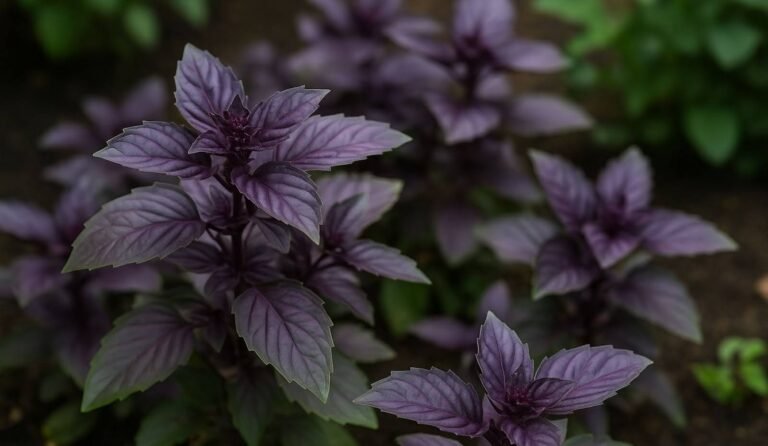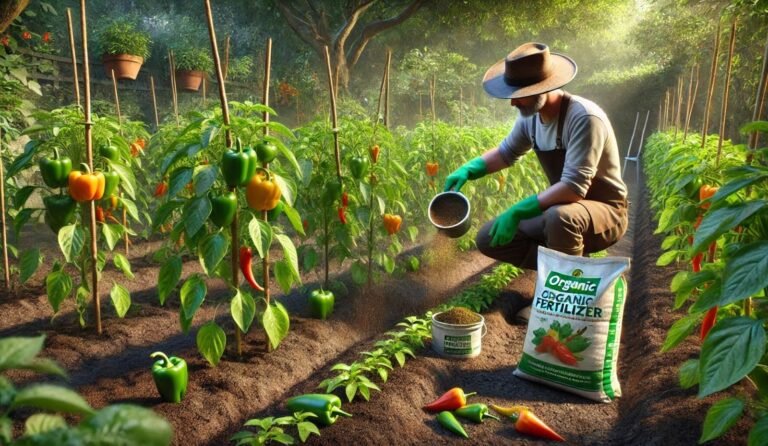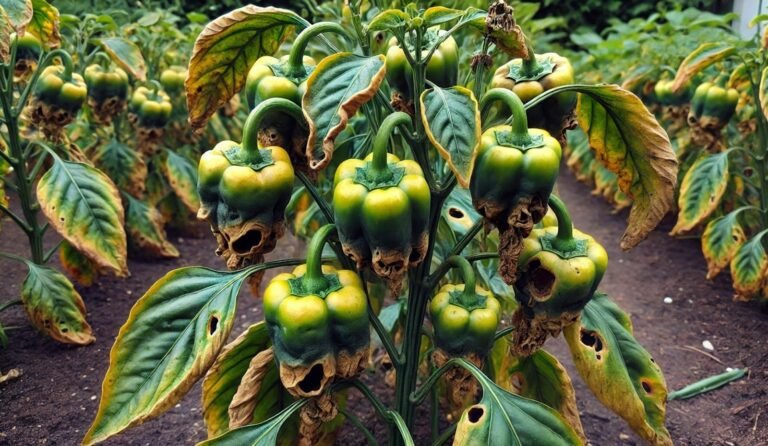Support for Tomato Plants: A Complete Guide to Healthy Growth
Tomatoes are one of the most rewarding crops to grow, whether in your backyard or inside your home. They’re delicious, versatile, and full of nutrients. However, to enjoy a bountiful harvest, tomato plants require a little extra care especially when it comes to keeping them upright and supported.
Support for tomato plants is a critical step in ensuring healthy growth, reducing disease risks, and simplifying harvesting. Without proper support, your tomato plants can topple under the weight of their fruit, become tangled, or suffer from pest infestations and rot.
In this guide, we’ll dive into everything you need to know about supporting tomato plants, including why it’s essential, different support methods, maintenance tips, and expert tricks to keep your plants thriving.
Why Supporting Tomato Plants Is Essential
Support for tomato plants- Tomato plants, whether determinate or indeterminate, aren’t naturally equipped to handle the weight of their growing fruit or withstand harsh weather conditions. Without support, they’re left vulnerable to a host of problems. Let’s explore why this step is non-negotiable for a successful harvest.
Key Benefits of Supporting Tomato Plants
- Prevents Damage from Wind and Weight
Heavy winds, rainfall, or the weight of ripening fruit can cause stems to break. A solid support system keeps your plants upright and prevents unnecessary stress. - Improves Airflow
By elevating the vines off the ground, you allow better airflow around the leaves and stems. This reduces the risk of fungal diseases like blight and powdery mildew. - Makes Harvesting Easier
Supported plants are much easier to navigate. With fruit lifted off the ground, you can quickly spot ripe tomatoes without disturbing the rest of the plant. - Boosts Fruit Quality
Tomatoes that touch the ground are more prone to pests, rot, and blemishes. Supporting the plants keeps the fruit clean and safe. - Saves Space
For gardeners with limited space, vertical supports like trellises or stakes allow plants to grow upward instead of sprawling outward.
Types of Tomato Plant Supports
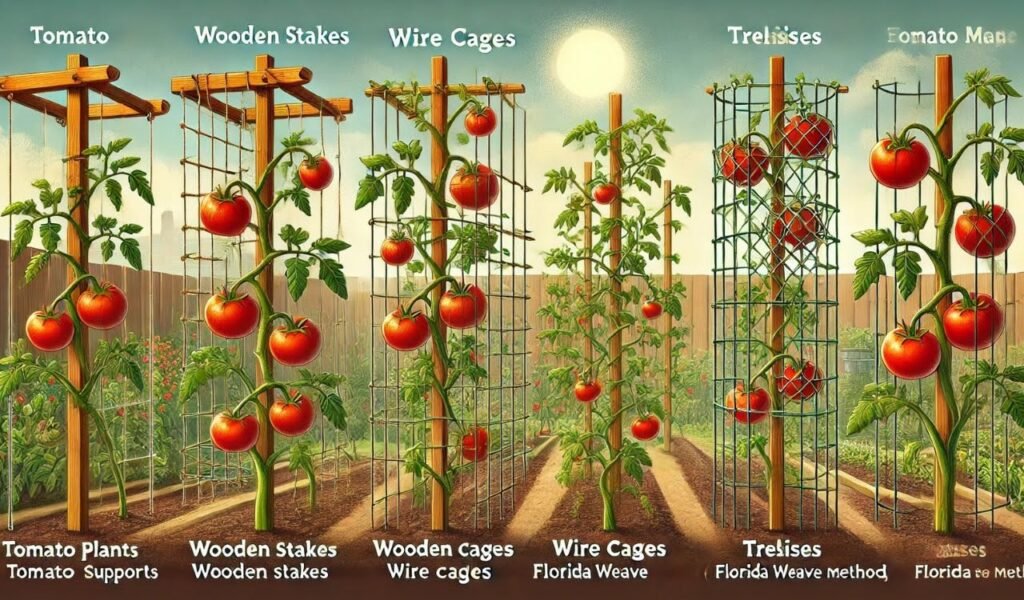
There are various ways to provide support for tomato plants, ranging from store-bought systems to DIY solutions. Each method caters to different gardening styles, plant types, and budgets.
Tomato Cages
Tomato cages are one of the most popular support systems.
Description: A circular or square frame that surrounds the plant, offering full support.
Best For: Determinate tomatoes, as these plants grow to a set height and don’t need excessive height support.
Advantages:
- Simple to use—just place the cage around the plant.
- Provides all-around support, ideal for heavy branches.
- Durable and reusable.
Drawbacks:
- Bulky and can take up space in small gardens.
- Not ideal for taller, indeterminate varieties.
Stakes
Staking is a classic and straightforward method.
Description: Long poles made of wood, bamboo, or metal, placed near the plant to hold it upright.
Best For: Indeterminate tomatoes that grow tall and require continuous support.
Advantages:
- Affordable and space-efficient.
- Perfect for vertical gardening.
Drawbacks:
- Requires regular tying as the plant grows.
- Provides less lateral support than cages.
Trellises
Trellises are excellent for gardeners looking to maximize vertical space.
Description: A flat or lattice-style vertical structure made of wood, metal, or string for climbing plants.
Best For: Raised beds or small garden spaces.
Advantages:
- Saves ground space while accommodating large plants.
- Creates an aesthetic, organized garden layout.
Drawbacks:
- Requires initial setup effort.
The Florida Weave
This method is perfect for large-scale gardening and row planting.
Description: Stakes are placed at intervals along a row, and twine is woven between them to support the plants.
Best For: Multiple plants in rows.
Advantages:
- Affordable and efficient for large gardens.
- Easy to adjust as plants grow.
Drawbacks:
- Requires straight rows; not ideal for scattered or small setups.
DIY Solutions
For gardeners on a budget, DIY options offer flexibility and creativity.
Examples:
- Old broomsticks or mop handles as stakes.
- PVC pipes or wire mesh for cages.
- String tied to overhead beams for vertical support.
Advantages:
- Cost-effective and customizable.
- Great for recycling household items.
Drawbacks:
- May require more effort and planning to construct.
How to Choose the Right Support
The best support system depends on several factors:
Determinate vs. Indeterminate Tomatoes
Determinate (Bush): Cages or short stakes are ideal as these plants grow to a fixed height.
Indeterminate (Vining): Taller supports like stakes or trellises are necessary to accommodate their continuous growth.
Space Considerations
Small Gardens or Raised Beds: Trellises or compact cages save space and make use of vertical growth.
Larger Gardens: Staking or the Florida Weave works well for supporting multiple plants in rows.
Budget-Friendly Options
DIY supports using recycled materials are cost-effective. Look for seasonal discounts or garden center sales for cages and stakes.
Step-by-Step Guide to Setting Up Supports
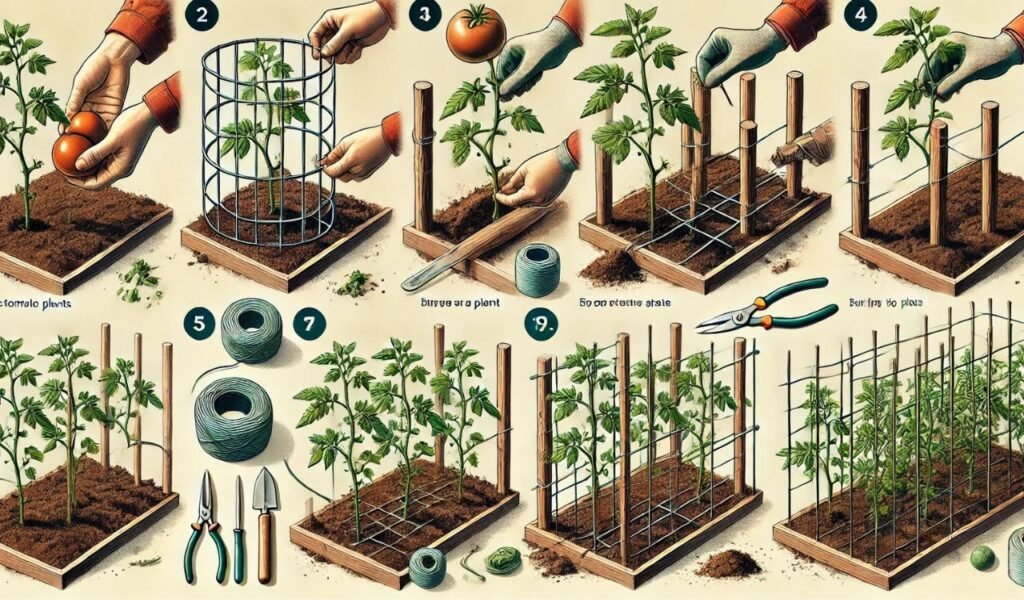
Step 1: Prepare Your Plants
Plant tomatoes with adequate spacing: 18–24 inches apart for determinate varieties and 24–36 inches for indeterminate ones. Ensure the soil is firm and well-draining to stabilize the support structure.
Step 2: Install the Support
Cages: Place the cage over the plant early in its growth and press it into the soil.
Stakes: Drive stakes 6–12 inches deep into the soil about 2 inches from the plant stem.
Trellises: Secure the frame firmly in the soil before planting.
Step 3: Tie Plants to Supports
Use soft materials like garden twine, cloth strips, or Velcro ties. Tie loosely to avoid damaging the stems. Adjust ties regularly as plants grow taller.
Advanced Maintenance Tips for Supported Tomato Plants
Once your supports are in place, regular maintenance ensures optimal growth:
- Weekly Inspections: Check for loose ties, leaning supports, or signs of damage.
- Pruning: Remove lower leaves or suckers to improve airflow and focus energy on fruit production.
- Feeding and Watering: Keep plants hydrated and provide a balanced fertilizer for continuous growth.
Common Mistakes to Avoid
Waiting Too Long to Provide Support
Installing supports after the plants grow can damage roots and stems. Always set up supports early.
Using Weak or Inappropriate Materials
Flimsy stakes or poorly constructed cages may collapse under the weight of mature plants. Invest in sturdy materials.
Overcrowding Plants
Overcrowding reduces airflow, leading to diseases and poor fruit production. Space your plants and supports adequately.
Quick Maintenance Checklist
Here’s a handy checklist to keep your tomato plants thriving:
- Adjust ties weekly to accommodate growth.
- Inspect supports for wear and tear.
- Prune excess foliage to improve airflow.
- Replace any damaged stakes or ties.
Frequently Asked Questions
Why do tomato plants need support?
Tomato plants need support to stay upright as their fruits grow heavier. Proper support prevents stems from breaking, improves airflow to reduce diseases, and makes harvesting easier.
How do I support tomato plants in raised beds?
For raised beds, vertical supports like stakes, trellises, or compact cages work best. These options save space and ensure the plants grow upward rather than sprawling over the soil.
When should I start supporting my tomato plants?
Start supporting your tomato plants as soon as you transplant them or when they are 6–12 inches tall. Early support prevents root damage and makes it easier to guide their growth.
Can I use household items to support my tomato plants?
Absolutely! Common household items like old broomsticks, PVC pipes, or even string tied to a sturdy beam can serve as effective and cheap tomato plant support. Just ensure the materials are sturdy and safe for plants.
How often should I check the supports?
Check your support weekly. Look for loose ties, leaning stakes, or signs of wear, and adjust or replace them as necessary to keep the plants secure.
Can I grow tomatoes without support?
It’s possible, but unsupported tomatoes are more prone to damage, disease, and poor yields. Supporting your plants ensures healthier growth and better fruit production.
What’s the difference between determinate and indeterminate tomatoes?
Determinate tomatoes: Bushy plants that grow to a fixed height and produce fruit all at once. Use cages or short stakes.
Indeterminate tomatoes: Vining plants that grow taller and produce fruit continuously. These need taller supports like stakes or trellises.
Conclusion
Providing the right support for tomato plants is a simple but vital step in ensuring healthy growth and abundant harvests. Whether you choose cages, stakes, trellises, or a DIY solution, a well-supported plant will reward you with better fruit quality and easier care. Regular maintenance, thoughtful planning, and avoiding common mistakes will keep your tomatoes thriving all season long. So, roll up your sleeves, choose your support system, and enjoy the satisfaction of growing your own delicious tomatoes. Happy gardening! 🌱🍅



